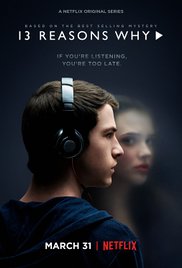13 Reasons Why Review

April 12, 2017
The recent hit web series entitled 13 Reasons Why has garnered the eyes and ears of society (primarily consisting of high school students and young adults) due to its overall theme of suicide prevention. This show features a familiar cast of actresses and actors which range from well-known stars such as Kate Walsh (who plays the mother of the protagonist) and Dylan Minnete (who plays Clay Jensen who is the primary narrator of the show) to newer stars like Devin Druid. As stated before, the show’s theme of suicide prevention has encapsulated the attention of modern society due to its deliverance of all the most common reasons why students and young adults resort to killing themselves (sometimes in the most grotesque ways) as a method of coping with unimaginable, unfair pain. This show introduces and expatriates upon these reasons through the utilization of tape recordings which feature the myriad of contributing factors to the self-execution of the protagonist.
Overall, this show accomplishes its purpose of bringing awareness to the issue of suicide through the familiar and attractive faces of its actresses as well as actors. The sense of familiarity elicited by seeing the face of Dylan Minnete (best known for his appearance in the movie Don’t Breathe and for looking similar to the actor Logan Lerman) and Kate Walsh (known for her appearance in the movie Perks of Being a Wallflower) will enable the viewer to provide more attention and care for scenes portrayed within this show. The attractive faces of the less known actors and actresses (such as the protagonist Katherine Langford and Brandon Larracuente) also produce a similar feeling of interest since these stars were selectively picked to appeal to the audience’s perception of attractive physical features.
Collaboratively, the show’s portrayal of certain events contributes towards interesting its audience. The directors demonstrated the first few episodes through the same camera angles to represent how this complex story is yet to unfold before the eyes of the viewers’ and becomes more and more unique as the show progresses. Towards the final episodes, the directors shifted the camera view from third person to first person (briefly) and immediately back to third person. Although these unpredictable camera angles tend to be unattractive to the majority of television viewers, these directors and producers effectively instituted brief shifts which deemed themselves conducive to the overall storytelling of this tragic occurrence at a high school. The directors also included some demonstrations of color symbolism as well through the exemplification of Hannah Baker’s (the protagonist of the show) depression through her constant appearance of blue or black clothing and nail polish which becomes more apparent as the show continues. They also use color symbolism when Hannah explains the events that contributed to her suicide by utilizing brighter colors which represented her past whereas the darker colors represented the present (in which was told through the life of Clay Jensen) which doesn’t include her. These techniques are basic in nature but effectively accomplish the job of storytelling without being too distracting.
In totality, this show deserves a whopping 3 out of 5 (even though it was rated 4.9 out of 5 stars on Netflix) stars due to the previously stated components of it. This show initially appears to be too sensationalized and entertaining due to its unrealistic portrayal of the average life of a high school student. This show runs upon loosely based generalizations which diminishes its overall credibility, thus producing unfavorable results. The writers and producers heavily focused upon receiving high amounts of views by constantly introducing one dramatic (and highly avoidable) situation after the next in which they later repented and attempted to resolve the flaws of the show by morphing these unrealistic occurrences into an ideal ones. The show also makes it near impossible to develop strong connections for the majority of their characters to the point where some of their viewers would be indifferent to any event that this character is subjected to. The only logical reason why the show received such high ratings is because of its impactful messages about rape, suicide prevention, and emotional support provided to others in which should already be demonstrated throughout society with or without the influences of a show such as this. Also, suicide is a highly sensitive topic in which the majority of people rarely know how to actually communicate about the topic due to low amounts of meaningful conversations about it. As a person who has consulted with a suicidal individual firsthand, this show does a somewhat accurate job at demonstrating the most primitive contributing factor (in which most people fail to realize that this is a massive generalization especially within the modern American society) to a person’s determination to end their own life. The take-home message of this show also contributes to its high rating since it was entrenched by Clay’s consultation with each person who neglected, abused, or failed to realize the emotions of Hannah Baker which resulted in her death. This message was ubiquitous throughout the show and began halfway through the season in which was based on the idea that society needs to provide more support and improve the ways that we treat each other in order to prevent more Hannah Bakers from being produced.










